1.Summary
This article is to describe how sql server automatically update statistics and how statistics influence execution plan .
2.When sql server automatically update statistics ?
SQL server automatically update statistics when change of rows reach 20%+500rows in a table .
3.Demo for statistics and execution plan change in table
--Check database statistic setting
SELECT name
,is_auto_create_stats_on
,is_auto_create_stats_incremental_on
,is_auto_update_stats_on
FROM sys.databases
WHERE name = db_name();
/*
is_auto_create_stats_on=1,is_auto_update_stats_on=1
indicate database "sample_db" auto create and update stats are on .
*/
--Create demo table
create table t1 (col1 int identity,col2 int) ;
--Insert 1500 records into table
select top 1500 identity (int,1,1) as n into #num from adventureworks2014.sales.SalesOrderDetail;
INSERT INTO t1 (col2)
SELECT n
FROM #num
DROP TABLE #num
GO
select min(col1),max(col1),min(col2),max(col2) from t1;

/*All the data in table t1 is even distributed .
total record in t1 is 1500 rows .
*/
--Display table t1 statistic infomation
EXEC sp_autostats 'sample_db.dbo.t1'

SELECT object_name(o.object_id)
,auto_created
,user_created
,stats_date(o.object_id, stats_id) AS StatisticUpdateDate
FROM sys.objects o
,sys.stats s
WHERE o.name = 't1'
AND o.object_id = s.object_id;

--Create non-clustered index on column col2
create nonclustered index ind_t1_col2 on t1(col2) ;
--Retrieve data from table t1
select * from t1 where col2=2;
--Display execution plan for query
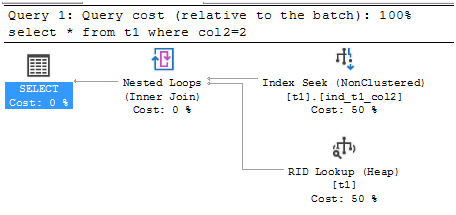
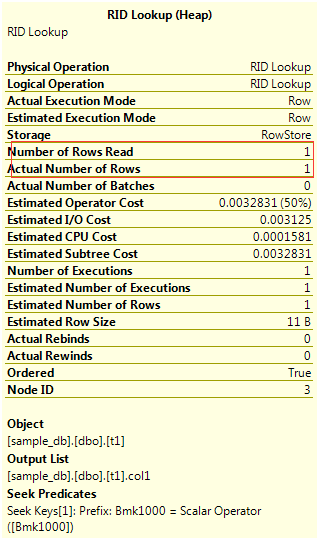
/*
Query access table t1 through index [ind_t1_col2]
Estimate number of row returned 1 .
This is the correct estimate number of row returned and nothing wrong with the execution plan .
*/
--How many rows needed for sql server to auto update stats?
--Modification of rows need to reach 20%+500rows to auto update stats.In this case ,need 800rows for sql server auto update stats.
select (1500*0.2)+500;
--Insert data into table t1 and see how stats change
--In this case ,insert 799 rows into table t1 and column col2 value is 2.
SELECT TOP 799 identity(INT, 1, 1) AS n
INTO #num
FROM adventureworks2014.sales.SalesOrderDetail;
INSERT INTO t1 (col2)
SELECT 2
FROM #num;
DROP TABLE #num;
--Check the table stats
EXEC sp_autostats 'sample_db.dbo.t1'

SELECT object_name(o.object_id),stats_id,s.name
,auto_created
,user_created
,stats_date(o.object_id, stats_id) AS StatisticUpdateDate
FROM sys.objects o
,sys.stats s
WHERE o.name = 't1'
AND o.object_id = s.object_id;

SELECT obj.name
,obj.object_id
,stat.name
,stat.stats_id
,last_updated
,modification_counter
FROM sys.objects AS obj
INNER JOIN sys.stats AS stat ON stat.object_id = obj.object_id
CROSS APPLY sys.dm_db_stats_properties(stat.object_id, stat.stats_id) AS sp
WHERE obj.name = 't1'

/*Stats is not updated as modification_counter didn't reach 800*/
--Retrieve data from table t1
select * from t1 where col2=2;
--Display execution plan
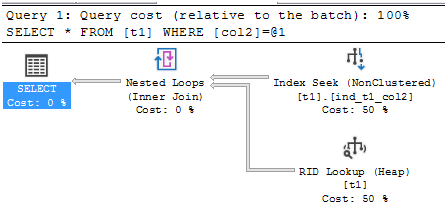
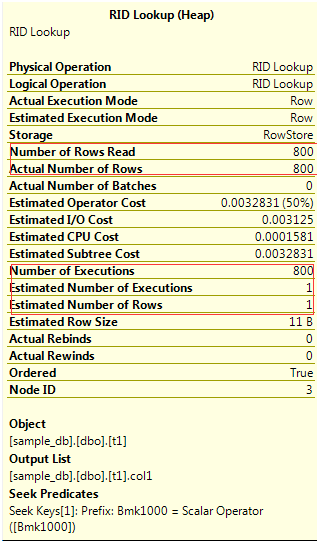
/*
Same query executed .
Since stats is out of date and optimizer have no idea about the data change .
So the optimizer just blinded reuse the old execution plan which cached in database .
From the execution plan , we can see that the estimate return rows is 1 ,
in reality actual return rows are 800.
Moreover , it has to perform 800 times table lookup and this will
lead to serious performance issue .
*/
--Let's insert one more record to the table t1 and see how's going ?
SELECT TOP 1 identity(INT, 1, 1) AS n
INTO #num
FROM adventureworks2014.sales.SalesOrderDetail;
INSERT INTO t1 (col2)
SELECT 2
FROM #num;
DROP TABLE #num;
--Retrieve data from table t1
select * from t1 where col2=2;

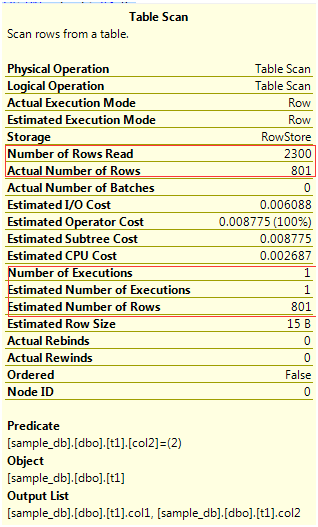
--Check the table stats
EXEC sp_autostats 'sample_db.dbo.t1'
SELECT object_name(o.object_id),stats_id,s.name
,auto_created
,user_created
,stats_date(o.object_id, stats_id) AS StatisticUpdateDate
FROM sys.objects o
,sys.stats s
WHERE o.name = 't1'
AND o.object_id = s.object_id;
SELECT obj.name
,obj.object_id
,stat.name
,stat.stats_id
,last_updated
,modification_counter
FROM sys.objects AS obj
INNER JOIN sys.stats AS stat ON stat.object_id = obj.object_id
CROSS APPLY sys.dm_db_stats_properties(stat.object_id, stat.stats_id) AS sp
WHERE obj.name = 't1'

/*
What happened when insert one more record into table t1?
When insert one row to table t1, the modification counter reached to 800 <threhold of auto stats update>
system automatically update table statistics .
When perform select query this time , optimizer is able to pickup the correct execution plan as stats
is up to date .
From the execution plan we can see the estimate return rows is 801 which is same as actual return rows
and number of execution is 1 and table access by full table scan .
*/
来自 “ ITPUB博客 ” ,链接:http://blog.itpub.net/28412973/viewspace-2152849/,如需转载,请注明出处,否则将追究法律责任。
转载于:http://blog.itpub.net/28412973/viewspace-2152849/





















 136
136











 被折叠的 条评论
为什么被折叠?
被折叠的 条评论
为什么被折叠?








